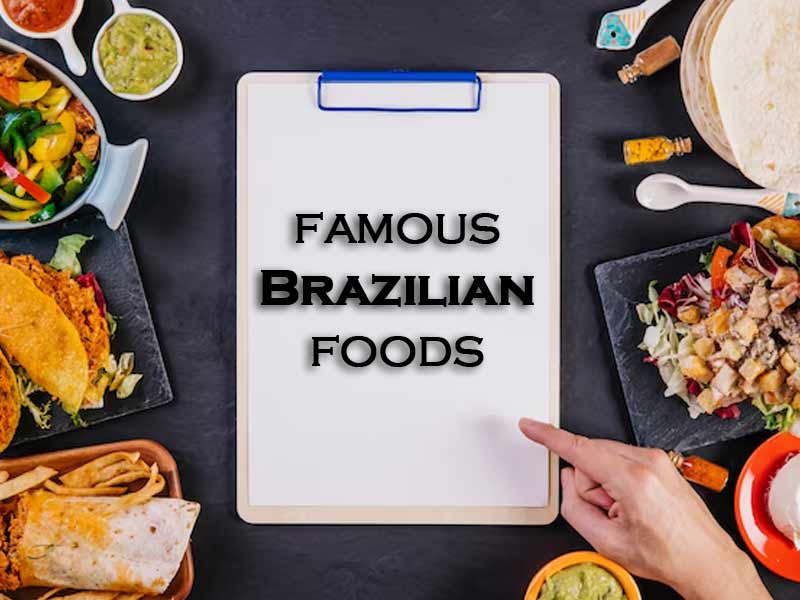Brazilian food is a vibrant and diverse cuisine that reflects the country’s rich cultural history and influences. The cuisine is a fusion of indigenous, European, African, and immigrant flavors and techniques, resulting in a unique culinary landscape that is both delicious and diverse.
One of the most famous dishes in Brazilian food is feijoada, a hearty stew made with black beans and various cuts of pork and beef. Often served with rice, collard greens, and orange slices, this dish is a staple of Brazilian food and is typically enjoyed at family gatherings and special occasions.
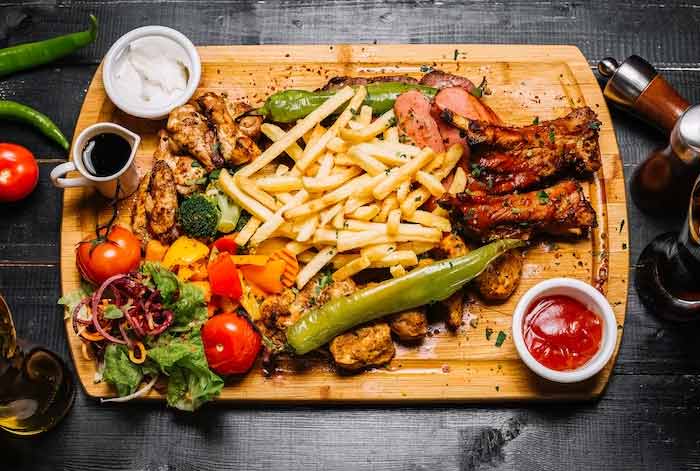
Another popular dish in Brazil is churrasco, a type of barbeque that originated in the southern region of the country. The dish typically involves grilling various cuts of beef, chicken, and pork, seasoned with a blend of spices and herbs. The meat is then sliced and served alongside traditional accompaniments such as farofa (toasted manioc flour), pão de queijo (cheese bread), and chimichurri sauce.
In conclusion, Brazilian food is a delicious reflection of the country’s rich history and cultural diversity. From the iconic feijoada to the smoky flavors of churrasco, Brazilian food offers a wide range of dishes that are sure to satisfy any palate.
Table of 40 famous Brazilian foods with brief descriptions
| Brazilian Food | Description |
| Feijoada | A hearty stew made with black beans, various cuts of meat, and spices. |
| Coxinha | A popular street food consisting of fried dough filled with shredded chicken. |
| Pao de Queijo | A cheese bread made with cassava flour and cheese. |
| Brigadeiro | A sweet treat made with condensed milk and chocolate. |
| Moqueca | A seafood stew made with fish or shrimp, coconut milk, and palm oil. |
| Churrasco | A style of barbecue that involves grilling various cuts of meat. |
| Farofa | A toasted flour made with manioc that is often served with rice and beans. |
| Açaí Bowl | A popular breakfast or snack bowl made with açaí berries, granola, and fruit. |
| Carne de Sol | A type of salt-cured beef that is popular in the Northeast region of Brazil. |
| Caipirinha | Brazil’s national cocktail made with cachaça, lime, and sugar. |
| Acaraje | A deep-fried fritter made with black-eyed peas and filled with shrimp, vegetables, or hot pepper sauce. |
| Quindim | A sweet, custard-like dessert made with coconut, sugar, and egg yolks. |
| Pastel de Feira | A fried pastry filled with meat, cheese, or vegetables. |
| Brigadeirao | A dessert similar to flan, made with condensed milk, chocolate, and eggs. |
| Xinxim de Galinha | A traditional dish from Bahia made with chicken, peanuts, coconut milk, and dendê oil. |
| Pudim de Leite | A creamy caramel flan made with condensed milk, sugar, and eggs. |
| Vatapá | A creamy stew made with bread, shrimp, coconut milk, peanuts, and dendê oil. |
| Quibebe | A pumpkin puree seasoned with garlic and onions. |
| Churrasco grego | A popular street food made with thinly sliced meat, usually beef, chicken, or lamb, wrapped in a pita or flatbread and topped with vegetables and sauce. |
| Cuscuz | A dish made with couscous, vegetables, and meat, usually served for breakfast. |
| Canjica | A sweet dessert made with boiled corn kernels, milk, and sugar. |
| Romeu e Julieta | A dessert made with guava paste and cheese. |
| Baião de dois | A rice and bean dish with various meats and vegetables |
| Feijao Tropeiro | A dish made with beans, sausage, bacon, and cassava flour, typically served with rice. |
| Bolo de Rolo | A cake made with thin layers of sponge cake rolled with guava paste. |
| Bolo de Fubá | A cornmeal cake often served with coffee or tea. |
| Caruru | A dish made with okra, shrimp, peanuts, and dendê oil. |
| Pamonha | A sweet or savory dish made with mashed corn, wrapped in corn husks and boiled or steamed. |
| Sarapatel | A stew made with organ meats, such as liver and heart, and seasoned with garlic, onions, and spices. |
| Maria-mole | A sweet treat made with coconut and condensed milk, similar to a marshmallow. |
| Arroz Doce | A sweet rice pudding made with milk, sugar, and cinnamon. |
| Tutu de Feijão | A dish made with mashed beans, cassava flour, and various meats. |
| Cachorro-quente | A hot dog with various toppings, such as corn, cheese, and sauce. |
| Rosca | A sweet bread typically served for breakfast, often flavored with coconut or cinnamon. |
| Bauru | A sandwich made with ham, melted cheese, tomato, and oregano. |
| Carioca | A type of deep-fried dough filled with various ingredients, such as cheese or meat. |
| Paçoca | A candy made with ground peanuts and sugar, often served during festivities. |
| Pé de Moleque | A candy made with roasted peanuts and sugar, similar to brittle. |
| Arroz de Carreteiro | A rice dish made with beef jerky and various vegetables. |
| Sopa Paraguaia | A savory cornbread made with cheese and onions. |
| Cocada | A sweet candy made with coconut and sugar. |
| Beijinho | A sweet treat made with condensed milk, coconut, and rolled in sugar. |
| Broa de Milho | A cornbread made with cornmeal and flavored with cheese, fennel, or anise. |
| Polenta | A dish made with boiled cornmeal, typically served with meat or sauce. |
| Escondidinho | A casserole made with mashed potatoes and various meats, such as beef or chicken. |
| Vaca Atolada | A stew made with beef ribs and yuca, typically served with rice. |
| Maria Isabel | A rice and beef dish with |
You can learn Brazilian Food Recipes here for free.
Brazilian culture

Brazil is a vibrant and diverse country with a rich cultural heritage that spans hundreds of years. From music and dance to food and art, Brazilian culture is a blend of African, Indigenous, and European influences that have been shaped over time by Brazil’s complex history.
Music
Music is an integral part of Brazilian culture, with various genres originating from different regions of the country. Samba is perhaps the most well-known Brazilian musical genre, originating in Rio de Janeiro in the early 20th century.
Other popular genres include bossa nova, forró, and axé music. Brazilian music is known for its rhythmic complexity, often featuring syncopated beats and complex percussion arrangements.
Dance
Brazilian dance is just as diverse as its music, with styles ranging from the energetic samba to the more acrobatic capoeira. Samba is often performed during Carnival, Brazil’s most famous celebration, which takes place annually in February or March. Capoeira, a martial arts-inspired dance, is also an important part of Brazilian culture, originating in the Afro-Brazilian communities of Salvador.
Food
Brazilian food is a fusion of African, Indigenous, and European influences, resulting in a diverse array of dishes and flavors.

Rice and beans are a staple in Brazilian food and are often served with meat, vegetables, and farofa, a toasted manioc flour. Other popular dishes include feijoada, a hearty stew made with black beans and various cuts of meat, and churrasco, a barbecue-style meat served with various side dishes.
Art
Brazilian art is as diverse as its culture, with influences from Indigenous, African, and European traditions. The Brazilian Modernist movement, which emerged in the early 20th century, was a significant moment in Brazilian art history, with artists such as Tarsila do Amaral and Candido Portinari producing works that reflected Brazil’s unique cultural identity.
Religion
Religion is an essential aspect of Brazilian culture, with Catholicism being the dominant religion. However, there is also a significant Afro-Brazilian religious presence, with religions such as Candomblé and Umbanda blending African, Indigenous, and Catholic beliefs.
Sports
Brazil is known for its passion for sports, particularly football (soccer). Brazilian football is renowned for its style of play, known as jogo bonito, or “beautiful game,” which emphasizes skill and creativity on the field. Brazil has won the FIFA World Cup a record five times, cementing its status as a football powerhouse.
In conclusion, Brazilian culture is a vibrant and diverse tapestry of music, dance, food, art, religion, and sports. Its blend of African, Indigenous, and European influences has created a unique cultural identity that is celebrated both in Brazil and around the world. From the rhythmic beats of samba to the delicious flavors of feijoada, Brazilian culture is a feast for the senses and a testament to the country’s rich history and cultural heritage.
Effective of culture on Brazilian food
The influence of culture on Brazilian food is significant, as it has played a crucial role in shaping the country’s culinary traditions.

Brazil’s unique cultural heritage, which is a blend of African, Indigenous, and European influences, has resulted in a diverse and vibrant cuisine that is celebrated both in Brazil and around the world.
African Influence
The African influence on Brazilian food culture is particularly evident in the country’s use of spices and seasonings. The use of chili peppers, garlic, onion, and palm oil in dishes such as moqueca, a seafood stew, reflects the African heritage of many Brazilian food (dishes). In addition, the use of okra, which is commonly used in West African cooking, is a staple ingredient in dishes such as feijoada, a hearty stew made with black beans and various cuts of meat.
Indigenous Influence
The Indigenous influence on Brazilian food culture is also significant, particularly in the use of native fruits and vegetables. Acai berries, for example, are a popular superfood that is used in smoothies and bowls, while manioc, a starchy root vegetable, is used to make farofa, a toasted flour that is often served with rice and beans. In addition, Indigenous techniques such as grilling and smoking have been incorporated into Brazilian cooking, as seen in dishes such as churrasco, a barbecue-style meat that is popular in Brazil.
European Influence
The European influence on Brazilian food culture is evident in the country’s use of meat, dairy, and wheat products. Portuguese settlers introduced various meats and dairy products to Brazil, including beef, pork, and cheese, which are commonly used in Brazilian food. Wheat products, such as bread and pasta, are also popular in Brazilian food, reflecting the influence of Italian and other European immigrants who have contributed to Brazilian food culture.
Regional Differences
Brazil is a vast and diverse country, with significant regional differences in food culture. For example, the cuisine of the Northeast region is heavily influenced by Indigenous and African traditions, while the cuisine of the South region is heavily influenced by European traditions. The cuisine of the Amazon region, on the other hand, is heavily influenced by local ingredients such as fish, manioc, and fruits.
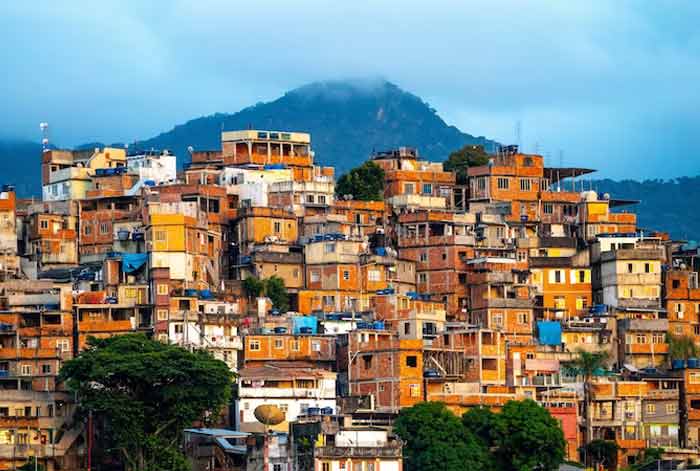
In conclusion, culture has had a significant impact on Brazilian food, shaping the country’s culinary traditions and resulting in a diverse and vibrant cuisine. The African, Indigenous, and European influences on Brazilian food culture are evident in the use of spices and seasonings, native fruits and vegetables, and meat, dairy, and wheat products. Additionally, regional differences in food culture highlight the diversity of Brazilian food and the important role that culture continues to play in shaping the country’s food traditions.
What is Brazilian food?
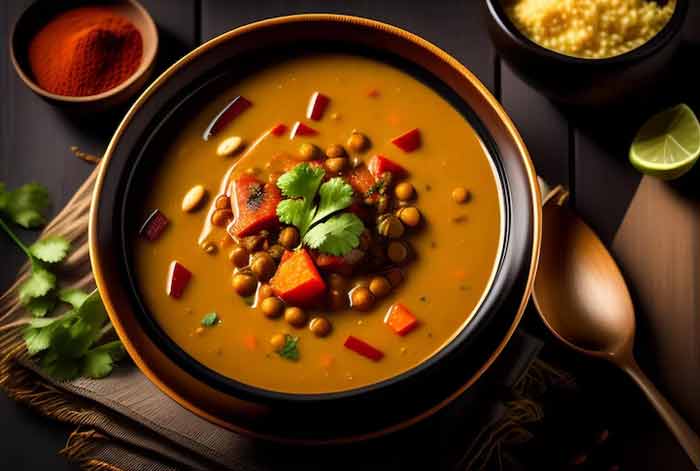
Brazilian food is a rich and diverse blend of influences from European, African, and indigenous cultures. The result is a vibrant and flavorful cuisine that varies greatly from region to region. In this article, we’ll explore the unique ingredients, dishes, and flavors that make up Brazilian food.
Staple Ingredients in Brazilian food
Brazil is a country rich in natural resources, and this is reflected in its cuisine. Some of the staple ingredients in Brazilian cooking include:
- Rice: Rice is a common accompaniment to many Brazilian food (dishes), such as feijoada and churrasco.
- Beans: Beans are a staple in Brazilian food, with black beans being the most commonly used variety.
- Meat: Brazil is famous for its meat, particularly beef. Churrasco, a type of barbecued meat, is a popular dish.
- Seafood: With a long coastline, Brazil has a strong seafood culture, with dishes such as moqueca, a seafood stew.
- Tapioca: Tapioca is a starch extracted from cassava roots and is used to make a popular street food snack called tapioca crepes.
Flavors of Brazilian food
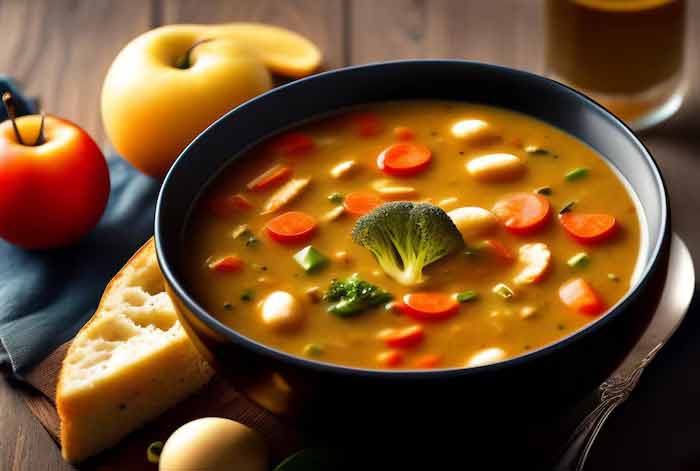
Brazilian food is known for its bold and flavorful combinations of spices, herbs, and seasonings. Some of the most commonly used spices and herbs include:
- Garlic: Garlic is a staple in Brazilian cooking, adding flavor to everything from meat dishes to stews.
- Cilantro: Cilantro is a popular herb used in Brazilian food, particularly in seafood dishes.
- Dendê oil: Dendê oil, made from palm oil, is a popular ingredient in many dishes from the Bahia region of Brazil. It gives dishes a distinctive orange color and a unique flavor.
- Malagueta pepper: This small, fiery pepper is a staple in Brazilian food, adding heat to dishes such as feijoada and moqueca.
In conclusion, Brazilian food is a melting pot of flavors and influences from various cultures. From hearty stews and barbecued meats to seafood dishes and sweet treats, Brazilian food offers something for everyone. So next time you’re looking to try something new, why not explore the rich and diverse flavors of Brazilian food?
Why Brazilian food is delicious?
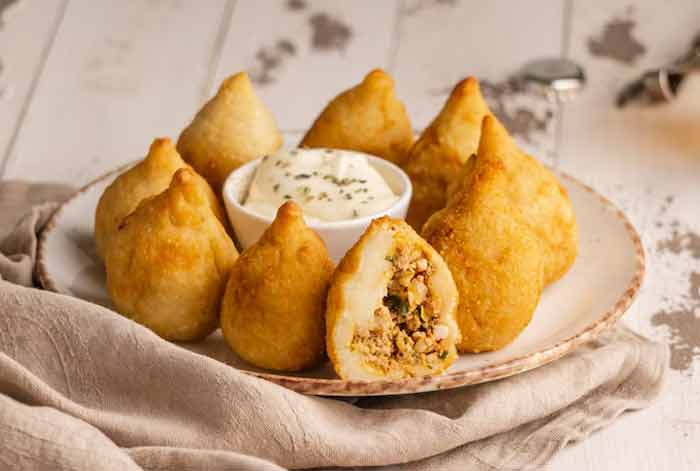
Brazilian food is a delicious blend of flavors and ingredients that have been influenced by the country’s diverse cultural history. The result is a cuisine that is vibrant, bold, and flavorful. In this article, we’ll explore some of the reasons why Brazilian food is so delicious.
Cultural Influences on Brazilian Food
Brazil’s cuisine has been influenced by the indigenous peoples who originally inhabited the country, as well as the Portuguese, who colonized Brazil in the 16th century, and the African slaves who were brought to the country to work on sugar plantations. This mix of cultures has resulted in a cuisine that blends flavors and ingredients from all three traditions.
Use of Fresh and Local Ingredients
One of the reasons why Brazilian food is so delicious is the use of fresh and local ingredients. With a vast array of natural resources available, Brazilian food makes use of a wide variety of meats, fruits, vegetables, and grains. These ingredients are often locally sourced and in season, ensuring the highest quality and freshest flavors.
Bold Spices and Seasonings
Brazilian food is known for its bold use of spices and seasonings. Garlic, cilantro, cumin, and paprika are just a few of the many spices commonly used in Brazilian food (dishes). Additionally, Brazilian food makes use of a variety of herbs, such as parsley, basil, and mint, to add depth and complexity to its dishes.
Unique Ingredients and Dishes
Brazilian food features a number of unique ingredients and dishes that set it apart from other cuisines. For example, farofa, a toasted manioc flour, is often served as a side dish with feijoada, a hearty stew made with black beans, pork, and beef. Additionally, dendê oil, made from palm oil, is a popular ingredient in many dishes from the Bahia region of Brazil, adding a distinct flavor and color to dishes such as moqueca, a seafood stew.
Street Food Culture
Brazil also has a vibrant street food culture, with numerous vendors selling snacks and small bites throughout the country. Popular street food items include coxinha, a fried dough stuffed with chicken or cheese, and pastel, a crispy fried pastry filled with a variety of fillings, such as beef, cheese, and vegetables. This street food culture adds to the overall richness and diversity of Brazilian food.
In conclusion, Brazilian food is delicious because of its blend of cultural influences, use of fresh and local ingredients, bold spices and seasonings, unique ingredients and dishes, and vibrant street food culture. With its bold and diverse flavors, Brazilian food is sure to please the palate of anyone who tries it.
Ingredients of Brazilian food
Brazilian food is a vibrant blend of flavors and ingredients that reflect the country’s diverse cultural history. With influences from indigenous peoples, Portuguese colonizers, and African slaves, Brazilian food is rich, bold, and varied. In this article, we will explore some of the key ingredients that are commonly used in Brazilian food.
Rice
Rice is a staple in Brazilian food and is often served as a side dish with many meals. Brazilian rice is typically prepared with garlic, onion, and oil, giving it a distinct and flavorful taste.
Beans
Beans are a crucial ingredient in many Brazilian food (dishes), including the famous feijoada, a hearty stew made with black beans, pork, and beef. Beans are also commonly served as a side dish and can be prepared in a variety of ways, including seasoned with bacon or served with farofa, a toasted manioc flour.
Meat
Meat is a significant part of Brazilian food, and beef, pork, and chicken are the most commonly consumed meats. Brazilian barbecue, or churrasco, is a famous style of cooking meat, where skewered meat is grilled over an open flame and served with various side dishes.
Cassava
Cassava, also known as yucca, is a root vegetable that is widely used in Brazilian food. It is often used to make tapioca flour, which is a key ingredient in dishes such as tapioca crepes and beijinhos, a coconut candy.
Coconut
Coconut is a versatile ingredient that is commonly used in Brazilian desserts and sweets. Coconut milk is used in many dishes, including moqueca, a seafood stew from the Bahia region, and cocada, a sweet coconut candy.
Dendê oil
Dendê oil, made from palm oil, is a staple in the cuisine of the Bahia region of Brazil. It is used in many dishes, including acarajé, a deep-fried bean cake filled with shrimp and spicy sauce, and moqueca, a seafood stew that is flavored with coconut milk and dendê oil.
Peppers
Peppers are a key ingredient in many Brazilian food (dishes), adding heat and flavor to a variety of dishes. Malagueta peppers are commonly used in Brazilian food, adding a spicy kick to dishes such as pão de queijo, a cheese bread made with cassava flour.
Tapioca flour
Tapioca flour is a staple ingredient in many Brazilian food (dishes), including tapioca crepes and beijinhos. It is made from cassava root and is gluten-free, making it a popular ingredient for those with dietary restrictions.
Fruit
Brazil is known for its abundance of fresh, tropical fruits, which are often used in juices and desserts. Popular fruits in Brazilian food include mango, passion fruit, guava, and pineapple.

In conclusion, Brazilian food is a flavorful and varied cuisine that utilizes a wide range of ingredients. From rice and beans to cassava flour and dendê oil, the ingredients used in Brazilian food reflect the country’s diverse cultural history and natural resources.
Popular Brazilian foods
Brazilian food is a diverse and vibrant reflection of the country’s rich history and cultural influences. From the indigenous peoples and European colonizers to African slaves and immigrant populations, Brazil’s culinary landscape is a delicious blend of flavors, spices, and techniques.
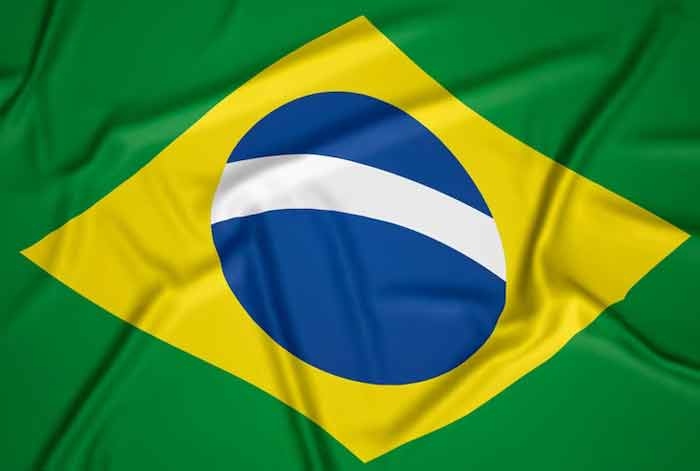
Feijoada is perhaps the most iconic Brazilian food (dish), a hearty stew of black beans and various cuts of pork and beef. Traditionally served with rice, collard greens, and orange slices, feijoada is a staple of Brazilian food and a popular choice for family gatherings and special occasions.
Another popular dish is churrasco, a type of barbeque that originated in the southern region of Brazil. Churrasco typically involves grilling various cuts of beef, chicken, and pork, often seasoned with a blend of spices and herbs. The meat is then sliced and served alongside traditional accompaniments such as farofa (toasted manioc flour), pão de queijo (cheese bread), and chimichurri sauce.
For those with a sweet tooth, brigadeiro is a beloved Brazilian treat. These chocolate truffles are made with condensed milk, cocoa powder, and butter, and rolled in chocolate sprinkles. Brigadeiros are a popular choice for birthday parties and other celebrations, and can be found at bakeries and cafes throughout Brazil.
Pão de queijo is another beloved Brazilian food snack, a cheese bread made with tapioca flour and cheese. These bite-sized treats are crispy on the outside and soft and chewy on the inside, and can be enjoyed on their own or with a cup of coffee or tea.
Coxinha is a popular snack consisting of shredded chicken wrapped in dough, battered and fried. These savory treats are often shaped like a teardrop and are a staple at Brazilian street food vendors and cafes.
In addition to these classic dishes, Brazil is home to a wide variety of regional specialties and local delicacies. From the seafood-rich dishes of the coastal regions to the hearty stews and soups of the interior, there is something for every palate in Brazilian food.
Overall, Brazilian food is a testament to the country’s rich history and cultural diversity. Whether you’re enjoying a classic feijoada with friends and family, savoring the flavors of a churrasco grill, or indulging in a sweet and creamy brigadeiro, the food of Brazil is sure to leave a lasting impression on your taste buds.
The last word is with you, the audience
Be sure to read other educational articles. For scientific issues, be sure to contact a specialist doctor. These materials are only for study and non-educational purposes. Of course, expert doctors can guide you a lot.
Our cooking training center has collected unique materials for you dear ones. This content is very useful and will help you cook the best and most delicious food for yourself and your loved ones at home.
Soon we will be with you with a more professional team with more facilities. We suggest that if you are overweight, fill out the and wait for our experts to contact you and send you the right meal plan.
Please follow us on linkedin. You can learn all best french food recipe and best Italian food recipe and best arabic food recipes and best canadian food recipes you can check our Reddit page.

